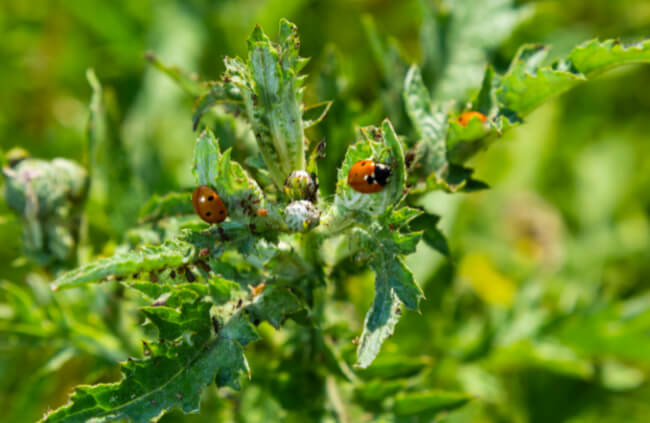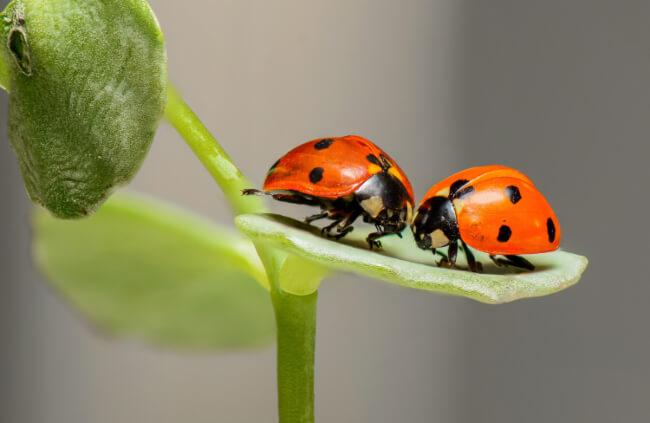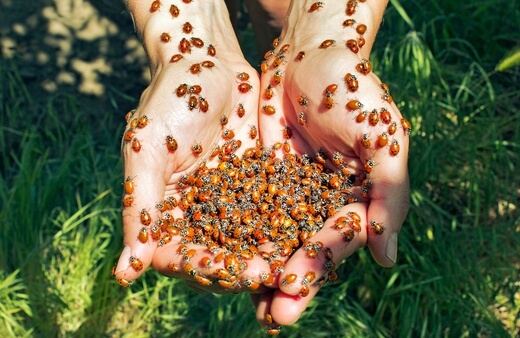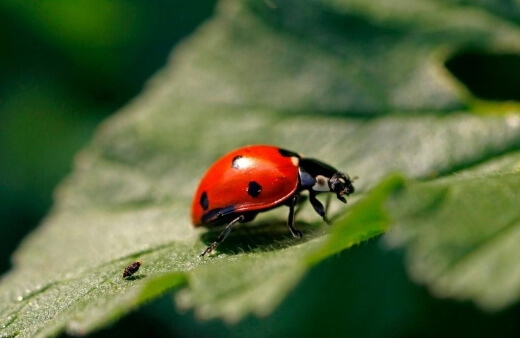Ladybugs, if you didn’t already know, are one of the most useful pieces of wildlife in your garden, and if they’re not already there, it’s easy to encourage them in. By feeding on aphids, greenfly, blackfly and all sorts of other pest insects, ladybirds and their larvae put a protective ring around your crops and your ornamental plants, as well as being pretty darn beautiful.
If you’re looking for ways to encourage ladybugs into your garden, then you’re in the right place. We’ve got a detailed guide on how to attract them, as well as the sort of foods they look for naturally, and how to keep them safe.
More...

Family: | Coccinellidae |
|---|---|
Species: | various |
Common Names: | Ladybug, Ladybird |
Type: | Winged, predatory insec |
Size: | Typically 5-10 mm, but can be larger |
Key features: | Bright red wing casings, with spotted markings |
Colour: | Red and black (some black and yellow, or black and white) |
Benefits: | Natural pest control |
Diet: | Aphids, whitefly, mealybug and scale insects |
What are Ladybugs?
Ladybugs is an American term that is fairly widespread, for a wide family of small beetles that are generally referred to as ladybird beetles, or ladybirds for short. They have two glossy red wing cases on their back, and a wide black thorax, usually with two false eyes.
Their tiny heads, with two short antennae and powerful mandibles, are discreet but incredibly adept at hunting down their prey. There are around six thousand accepted species of ladybugs across the world, with most spreading across continents, and falling into at least seven subfamilies, and dozens of genera.
What is a Ladybird’s Natural Habitat?
Ladybugs live in every part of the world where there are plants to host them. They can reach altitudes of 1,100 m and fly distances of 75 miles in a single journey. They can cope with extreme heat, and survive extreme cold.
Basically the only prerequisite for ladybug life, it would seem, is food. As such they have never been observed in Antarctica, and are rare in any icy habitat.
Ladybugs' Lifecycle
Ladybugs breed from autumn through to spring in Australia, though in cooler parts, they may also breed in early summer, while hibernating through winter.
After a successful breeding season (which can see females lay up to 1000 eggs over a year-long lifespan) the eggs are laid in batches of 50 on the underside of leaves and left to fend for themselves when they hatch.
When eggs hatch, the larval stage is a short, thin black creature, which scuttles across leaves and up stems in search of aphids and other insects. On most species, the larval stage is black, with orange, red or white stripes down either side and looks slightly like a short, pointed caterpillar.
The larva then pupates, following several moultings, developing a hard shell and fusing the legs to its body, and most importantly, develops wings. Strangely, during the pupal stage, they do move away if they are disturbed, unlike other pupating insects which are entirely dormant.
At every stage, their main food source is aphids, but they will also eat mealybugs, scale insects, ants, and any other insect smaller than themselves.
Benefits of Ladybugs in the Garden
Ladybugs are infinitely beneficial in our lives. They not only guard our flowers and food from troublesome pests, but they even fertilise flowers as they move around.
While we think of them as carnivorous, they still enjoy a treat of sugary nectar, so are an essential part of the pollination chain, flinging from plant to plant to move pollen around our gardens.

What Insects do Ladybugs Eat?
Ladybugs mainly eat small insects, but they are so effective at that, that they will also search for eggs too, eating the spider mite, aphid, mealybug, or thrip eggs that are anywhere to be seen.


Get Your Free Guide:
Master Growing Australian Natives eBook
A Must Have Complete Guide for Every Australian Garden
Get Your Free Guide:
Master Growing Australian Natives eBook
A Must Have Complete Guide for Every Australian Garden
Like all beetles, they are quite powerful, and comparatively heavy, with large bodies that are capable of pinning down their prey, meaning they can feast on many surprising pests, including ants.
One of the more unusual parts of their diet, which likely supports their immune system, or offers some health benefit, is that they eat fungal spores, including mildew, so they even act as a disease prevention shield for your plants.
A typical ladybird diet, while pretty much impossible to define, looks something like this:
- Ants
- Aphids
- Aphid eggs
- Blackfly
- Spider mites
- Fallen leaves
- Fungi (including mildew)
- Mealybugs
- Nectar
How to Identify Ladybugs
Ladybugs are super easy to spot. They are domed beetles with two symmetrical wing cases, usually red with black spots, but sometimes orange with black stripes, or black with white spots – or some combination of those colours.
Perhaps more importantly, how do we spot ladybug larvae? They can easily look like pests themselves, but rest assured, these clever little young beetles are doing your plants the world of good.
They have short bodies, pointed at the back, with tiny spines, and a rigid covering. Either side of their body usually has distinct stripes of red, white, orange or yellow stripes. And the clearest way to identify them is to watch them for a minute, as they are nearly always heading toward prey.

Where to Find Ladybugs on Plants?
Ladybugs will usually lay eggs on the underside of leaves, in groups of up to fifty, but sometimes as few as five. Their eggs are small orange balls, in tight groups.
When they hatch, their larvae are easiest to spot on the stems of plants and young shoots. Ladybugs know the plants that their aphid prey will likely be on, and routinely travel between them.
You are most likely to find them on beans or brassicas, near growing tips, but most herbaceous plants can host them too.
Tips for Encouraging Ladybugs Naturally
Nothing will encourage ladybugs more than letting go of control, just a little. Allow any brassicas to go to seed. Let your herbaceous plants stick around for a little longer than usual before cutting them back in winter.
Encourage a wildflower area in your lawn. And most importantly, don’t ever spray insecticides to remove aphids. It’s ironic, but to manage aphid populations in your garden, you need to allow them to exist.
Ladybugs will manage their population, but only if they are there to begin with.
So, to encourage ladybugs:
- Stop using pesticides
- Stop using fungicides
- Leave dry stems in the garden until spring
- Introduce plants to attract ladybugs
Best Plants to Encourage Ladybugs
Flat headed plants, and plants with scented foliage seem to attract ladybugs – pelargoniums, and geraniums are great for scent.
- Yarrow
- Queen Anne’s Lace
- Angelia, Cosmos
- Fennel, Dill
- Ammi Majus
- Dill
- Coriander
- Tansy
- Sambucus
They are all incredible plants to attract any pollinators to your garden, but especially ladybugs, who have short tongues, and need accessible flat or open flowers to get sugary nectar from through a long season.
Habitats and Garden Conditions for Ladybugs to Thrive
Ladybugs hibernate through cold winters, and like all beetles need log piles, or dry spaces to stay safe from birds and other predators. Either create a purpose built log pile, or introduce a bug house with wide open holes and layers. Even old slates stacked up can offer spaces.
The best way to offer homes to ladybugs and predatory beetles over winter though, and it’s probably the least attractive option for most gardeners, is to let your garden droop naturally.
Don’t cut back herbaceous plants in autumn unless they need it. Leave it until spring, when new growth is emerging. Ladybugs will be in the dry, decaying, stems and be in exactly the right place when new growth emerges in spring.
Introducing Ladybirds Manually
There are some stores in Australia that offer live ladybugs for sale. They breed native ladybugs, and package them safely and humanely for release in your garden. If there is food, such as aphids, those ladybugs will stick around and you can quickly boost your natural pest control options, and if not they’ll simply fly off.
Either way, it’s humane and helps to boost the population of native ladybugs.

Can You Introduce Ladybugs Indoors for Houseplants?
It might not seem that appealing, but you can actually release ladybugs inside, for some indoor biological control of houseplant pests. By releasing a few ladybugs or their larvae (either caught from outside, or bought online) onto your houseplants directly, they will devour the insects that are there, and then just leave through an open window when there’s nothing left.
It might sound weird, but I’ve tried it several times. It works particularly well if you can leave a few ladybug larvae on your houseplants as they will eat everything before pupating, and then leaving (adult ladybugs have a tendency to fly off as soon as they’re bored).
Ladybugs Frequently Asked Questions
How do ladybugs protect themselves?
If you’ve ever seen a cat try to catch a ladybug, you’ll know exactly how they protect themselves. It’s a trait shared with many small insects. They secrete a foul-smelling juice, which is simply disgusting, and 99% of the time, they get left alone.
What is the lifespan of a ladybug?
Ladybugs have a surprisingly long lifespan, of around 1 year, though many will survive winter, and can often live up to two years in the wild.
Why do I have ladybugs in the house?
If you’ve got ladybugs in the house, it’s probably because the weather outside is getting colder and they’re looking for a hibernation spot. They’re not doing any harm so you can just leave them be, or move them to some sort of bug shelter in the garden.
Can ladybugs survive in a house?
Ladybugs can survive in a house quite easily over winter, and it’s a perfect hibernation spot for them. In spring, they will usually leave of their own accord. If you find ladybugs indoors in summer, try to coax them outside as they won’t last long without aphids to eat.
What month do ladybugs come out?
Ladybugs are most active from spring to autumn, but in warmer parts of the country, can hide away through summer, and are actually more active through the cooler months.
Can ladybugs lay eggs in your house?
Ladybugs can lay eggs in your hour, but it would be unusual. They prefer to lay eggs on the underside of leaves, so they know their offspring will have an instant food source when they hatch.
Why do ladybugs leave a mark on clothes?
If you’ve ever noticed ladybugs leaving a mark on clothes, it’s a protective secretion. It’s pretty disgusting, and it smells awful close up, but it’s harmless, and should wash out easily.

What are the orange ladybugs?
Orange Asian ladybugs can bite humans. They don’t have venom, but are more defensive, so if they feel threatened or like they are on an unusual surface they can bite, which will leave a small red mark. Some small animals may have severe reactions to mild toxins in their bite.
What is the difference between a ladybird and ladybug?
There is no difference between a ladybird and ladybug. ‘Ladybird beetle’ is the given name by entomologists as it makes it clearer that they are not bugs. Ladybugs is the American term, though bugs technically refers to a specific order of insects called Hemiptera (including shield beetles, leafhoppers, and bed bugs).
How many aphids does each one eats?
While in the pupae stage, each ladybug will consume more than 350 aphids each. Then once they become an adult the number can increase to more than 5000 in its lifetime.
Where ladybugs they go in winter?
They hibernate just like many cold-blooded animals. You will possibly find them in attics, crevices in the wall or anywhere that’s dry, warm, and out of the elements.
Are there ‘male’ ladybugs?
Of course. Ladybugs are sexual insects and mate similarly to many animals.
Are the orange ladybugs the male?
No. Male and female of each species look very similar apart from some minor differences and can rarely be split apart. Ladybugs come in all shapes, colours, and sizes. Some are black, some are black with red dots, others are red with black dots, orange with black dots, striped, mottled you name it they seem to come with that design.
Red Ladybugs are lucky?
Why do we attribute ‘luck’ to an animal or insect? You’re lucky if they turn up in your garden but it doesn’t matter what colour they are so long as they have an appetite.
Wrapping Up Our Guide to Ladybugs
Ladybugs deserve so much more credit than they get. We’re definitely more aware of their benefits today than we were a few decades ago, and most of us are much more pro-bug generally, but there’s further to go.
These little red soldiers help to protect our plants from everything from fungal spores to aphids. They help to pollinate our crops, and flowers, and they look good doing it. So hopefully we can all celebrate and encourage the humble ladybug a little more often.
Published on August 11, 2023 by Nathan Schwartz
Last Updated on September 20, 2025


